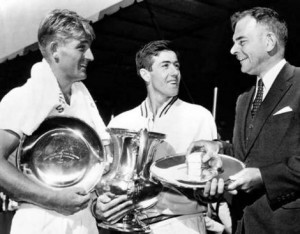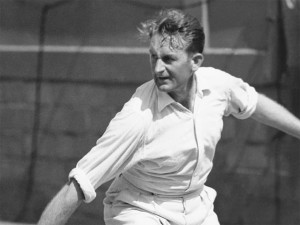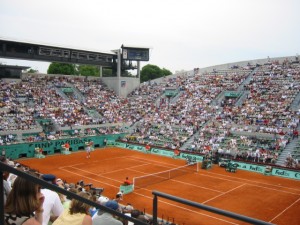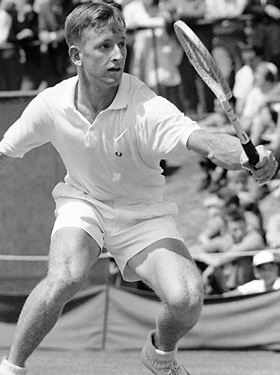By Randy Walker
@TennisPublisher
There is much talk about the five players who have completed the six Grand Slams in the history of tennis – Don Budge (1938), Maureen Connolly (1953), Rod Laver (1962, 1969), Margaret Court (1970) and Steffi Graf (1988). However, what about players who have failed in their attempts to achieve the ultimate in tennis?
The first player to fail in an attempt to win all four majors in a calendar year happened before the first Grand Slam was even achieved. It was 1933, and Jack Crawford from New South Wales, Australia won the Australian, French and Wimbledon championships and reached the final of the U.S. Championships at Forest Hills where he faced Fred Perry of Great Britain. Crawford led Perry two sets to one – one set from winning the first-ever Grand Slam – but won only one game in the final two sets, losing the final 6-3, 11-13, 4-6, 6-0, 6-1.
Budge, the first player to win the Grand Slam in 1938, five years after Crawford’s effort, wrote in his official biography “Don Budge: A Tennis Memoir” that, incredibly, Crawford drinking too much brandy was the reason for the one-sided scores in the final two sets.
“Jack was asthmatic, and particularly, on the hotter, muggier days – as this one was – the condition could begin to bother him,” wrote Budge of Crawford playing Perry in the final of the U.S. Championship on September 10, 1933. “To help his breathing in these circumstances, Crawford would often take a bracing shot of brandy before a match, or, if conditions warranted, even in the midst of one. Against Perry and, no doubt, also against a high autumnal pollen count, frankly, Crawford started hitting the brandy too hard. He had two or three ponies, and his coordination began to suffer. Fred, cold sober, lost only one game to Crawford in the last two sets and thus ended his chances for the first Grand Slam.”
While Crawford did not make history by becoming the first Grand Slammer, his effort helped coin the “Grand Slam” term as, leading into the U.S. Championships, John Kieran of the New York Times wrote in his column, “If Crawford wins, that would be something like scoring a grand slam on the courts.” As Bud Collins writes in his book “The Bud Collins History of Tennis,” a reporter with the less known Reading Eagle newspaper in Pennsylvania named Alan Gould also referred to a potential Crawford sweep as a Grand Slam just after Crawford won Wimbledon in July, but since his paper was not as prominent as the New York Times, Kiernan generally received the credit for first coining the term in tennis. Allison Danzig, the famed New York Times tennis reporter, wrote in his match of Crawford’s loss to Perry that “Crawford’s quest of the Grand Slam was frustrated.”
Connolly won the second Grand Slam in 1953, and three years later in 1956, Lew Hoad from Australia had the opportunity to be the third. He entered the U.S. Championships having won the Australian, French and Wimbledon titles and as the top-seed cruised into the final at Forest Hills to face his Davis Cup teammate and No. 2 seed Ken Rosewall, whom he beat in the Australian and Wimbledon finals earlier in the year. After winning the first set – only two sets from finishing up the Grand Slam – Hoad ran into a buzz-saw, as Rosewall caught fire and prevented history with a 4-6, 6-3, 6-3, 6-3 upset.
“A lot of people rubbed their eyes and took another look—even Hoad,” wrote Bill Talbert in Sports Illustrated. “Rosewall completely took charge once he got into the driver’s seat. Down 0-2 in the third set, he took 12 of the next 16 games. He was the master—a crafty tailor sewing a garment of defeat for his victim. Rosewall at the finish was so overpowering that in the final set, Muscles, as he’s called by his teammates, lost only three points on his own service.”
News footage and commentary on Hoad’s quest and failure can be seen here in this YouTube video: https://www.youtube.com/watch?v=Hl0D4Kt27Yk
Rosewall and Hoad’s fellow Australians Laver and Court won the next three Grand Slams – Laver turning in the four-major sweep in 1962 and again in 1969, when tennis became “open” to pros and amateurs. Court won all four majors in the 1970 year, one year after Laver’s second.
However, before Graf’s feat in 1988, Martina Navratilova had an opportunity to join this most elite group in 1984. The site of Navratilova’s near accomplishment, however, was not New York, but Melbourne, Australia as the Australian Open was in the early 1980s, the final leg of the Grand Slam, being played in late November, early December.
Navratilova won the French, Wimbledon and U.S. Open titles in 1984 and had won six straight major titles starting with Wimbledon in 1983. However, Navratilova was denied in her calendar-year Grand Slam quest, losing to a 19-year-old Helena Sukova 1-6, 6-3, 7-5 in the semifinals, ending her incredible 74-match win streak.
”How important is anything?” the 28-year-old Navratilova said after the loss. ”It hurts, but I’ll get over it. I still have two arms, two legs and a heart.”
”If I’d have won, I’d have done it all,” Navratilova said of her quest for the calendar-year Grand Slam. ”If I lost I had to start from scratch. Both are hard to cope with.”






